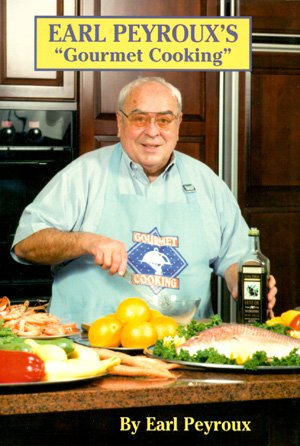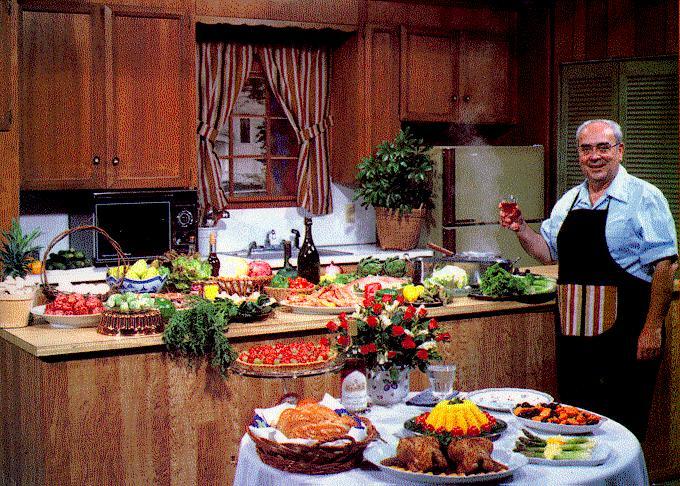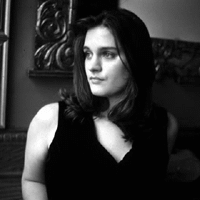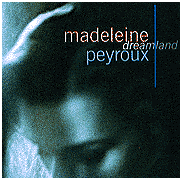1) Earl PEYROUX : le cousin créole cuisinier venu du Poitou vers 1740
On a
retrouvé notre "cousin" créole cuisinier (ou
est-ce celui de Maïté version USA ?) sur le web aux
adresses suivantes:
http://pelicanpub.com/cookbooks/earl-peyroux.htm et http://uwf.edu/tprewitt/sofood/cajun.htm

"Earl Peyroux's 'Gourmet Cooking' is a fascinating and eminently practical book that distills a lifetime of culinary exploration into easy-to-prepare and delicious recipes spiced with the author's informed commentary."
Stanley Dry, editor, Louisiana Cookin'
Celebrity chef Earl Peyroux has taught millions of viewers the joys of "Gourmet Cooking" through more than 600 episodes of his national PBS television show and six companion cookbooks. Now, for the first time available in stores, Peyroux offers a combination of show favorites and never-before-seen dishes designed to sate the appetites of his most ardent fans.
Part of the appeal of his easy-to-follow recipes lies in his broad culinary repertoire. Peyroux incorporates techniques he learned from cooking with his mother in New Orleans, living along the Northern Gulf Coast, and attending the prestigious Le Cordon Bleu cooking school in Paris.
New Orleans' Cajun Jambalaya, the Gulf Coast's Pickled Shrimp, and Paris' Coquille Saint Jacques Provençal (Sautéed Scallops with Tomato and Garlic) reflect Peyroux's gumbo of styles and influences. The result is a compilation of deliciously diverse dishes that anyone will enjoy preparing as much as eating.Earl Peyroux's "Gourmet Cooking" has aired on PBS stations since 1977, but his passion for food dates back much further. Peyroux learned the benefits of good cooking and good eating as a young boy in the culinary capital of the United States: New Orleans. Since then, he has traveled throughout the world, both learning and teaching all he can about gourmet cooking.
TIME
WELL SPENT WITH EARL PEYROUX
Interview on 7 December 1996 by Cindy Beggs and
Bridget Gipson
Preface
Earl
Peyroux was born in New Orleans in 1924. His ancestors
came from France and moved directly to New Orleans in
1740. Earl began his cooking show, Gourmet Cooking,
in 1977, which aired nationally in 1982. In 1996, he
retired from his cooking show for health reasons; he is
currently at work on his next cookbook. The following
information is transcribed from a very candid interview
with Chef Peyroux. Earl's thoughts, feelings, and desire
to keep his tradition alive and thriving for all of us to
appreciate and enjoy truly describes him as an 'ethnic hero'.

"My family came to Louisiana in the 1740's and they were rather prominent people. One of the first settlers in my family, M.J. Gabriel Peyroux, became licensed by the King of Spain to be the first civilian pharmacist in New Orleans. He was quite prominent in the local community. His son, J.M.G. Sylvain Peyroux, was a wine merchant who lived on Toulouse Street in New Orleans and built a plantation south of New Orleans, in what is now called Arabi. This plantation was built in 1830 and was called Three Oaks. Sylvain married about that time and had four children. He introduced rice to the St. Bernard area from the Caribbean. His plantation home existed until 1964 when the property owner, American Sugar Refining Co. (Domino Sugar) had it bulldozed even though it was in perfect condition. They could not have done that today because there are all kinds of protective laws for historical places. This was a building that they had spent a lot money fixing up, and overnight somebody in their organization decided they didn't want it standing. They just bulldozed it down. There was a big cry in New Orleans that day."
"There were Acadians who left France and went to Canada. They lived in Canada until they were exiled because they wouldn't swear allegiance to the English Crown. They came down the river and settled in southwest Louisiana and in and around New Orleans. Those are called Cajuns or Acadians (from a region of the same name in France). Then there were the who left France and came directly to New Orleans. Today, these groups are known mainly as the Creole, whereas those that came from Canada were called Acadians, shortened to 'Cajun'. The third group of people were Acadians directly from France. These people were very poor and had trouble even existing."
"One of my relatives that came over here was Henry Peyroux. He was apparently a diplomat involved with the Spanish Government. He convinced the King of Spain to pay and to get the King of France to permit those Acadians still in France to come to Louisiana. They came and settled above New Orleans on both sides of the river. Of course, when they got there they joined the Acadians that came from Canada. So there were three sources: there were the Acadians who came from Nova Scotia down the (Mississippi) River, there were Acadians still in France that were brought to Louisiana by the King of Spain, and there were who primarily came directly from France to New Orleans. The immigration was brought about by a number of things, including economic conditions in France and affluent people speculating about the New World. Additionally, there was a lot of promotion, fund raising, and connivery regarding Louisiana. John Law, a banker in France, who promoted Louisiana as a paradise. This promotion brought a lot of people over to the New World looking for a new way of life. Many people invested in land. A lot of people came with money and acquired land grants. They established large plantations and so forth. Now of course, with all of that you had slavery; slaves were being brought from Africa. These slaves made the mainstay of the economics of the area because they did all the work. They worked the farms and the plantations, and served the aristocracy. These people were clearly divided from the upper class. The economy in Louisiana grew that way.
"Everyone lived in the swamp; even New Orleans was underwater practically all the time in those days! Many Frenchmen got land grants from the government and developed huge plantations up the river toward Baton Rouge and St. James, Louisiana. Some of my immigrant ancestors had property up the river and also in New Orleans."
"New Orleans is called the "Crescent City" because the city was built on the crescent of the Mississippi River. Once you walked out of what is now the French Quarter, you crossed what is Rampart Street and you were now out in the boondocks. People ultimately bought that land and developed it. My ancestor, M.J. Gabriel Peyroux, the pharmacist, lived in New Orleans with his wife. They had land up around Bayou St. John. Bayou St. John was the connector between the River and Lake Ponchartrain, so a lot of supplies to keep the city going came from various places through Lake Ponchartrain down Bayou St. John, which was an income producing property. Later, he dismantled and rebuilt this home on the corner of Dumaine and Burgundy. It is now a bed & breakfast in the historical district.
"The Peyroux family are Creoles. We are not Cajuns because we did not come from Acadia through Nova Scotia or directly from France by virtue of the King of Spain. My family came from Poitou, a province in France. The Peyroux family was very prominent in the pre-civil war era. This war ended the South's glorious economy and the Peyroux family literally went from riches to rags. They no longer had the slave help to keep up the work on the plantations and they lost their land and had to move in town."
On moving to Pensacola:
"My family stayed in Louisiana until my generation. I left 35 years ago. Living in New Orleans got more and more complicated. I got sand in my shoes and I moved to Pensacola."




